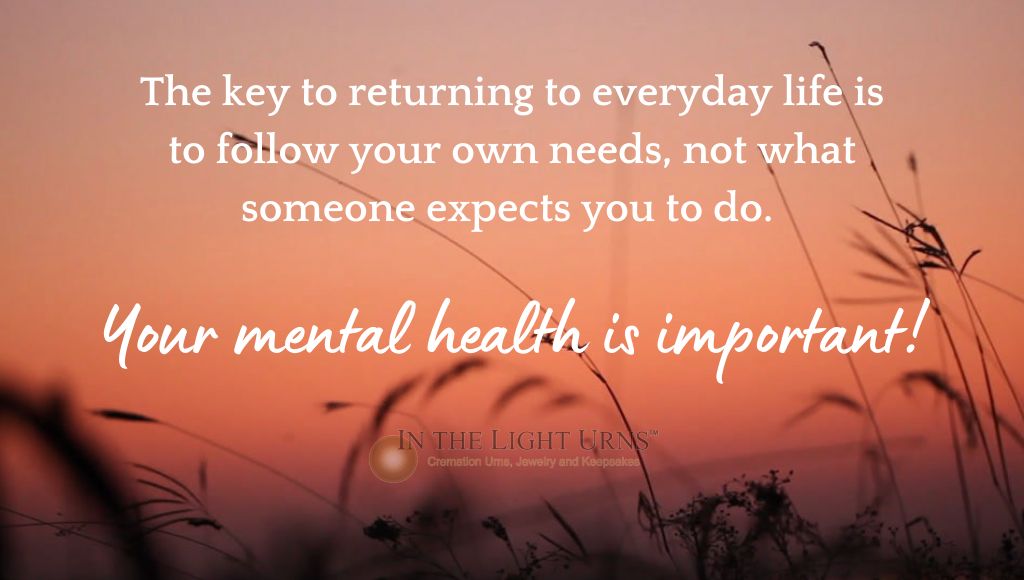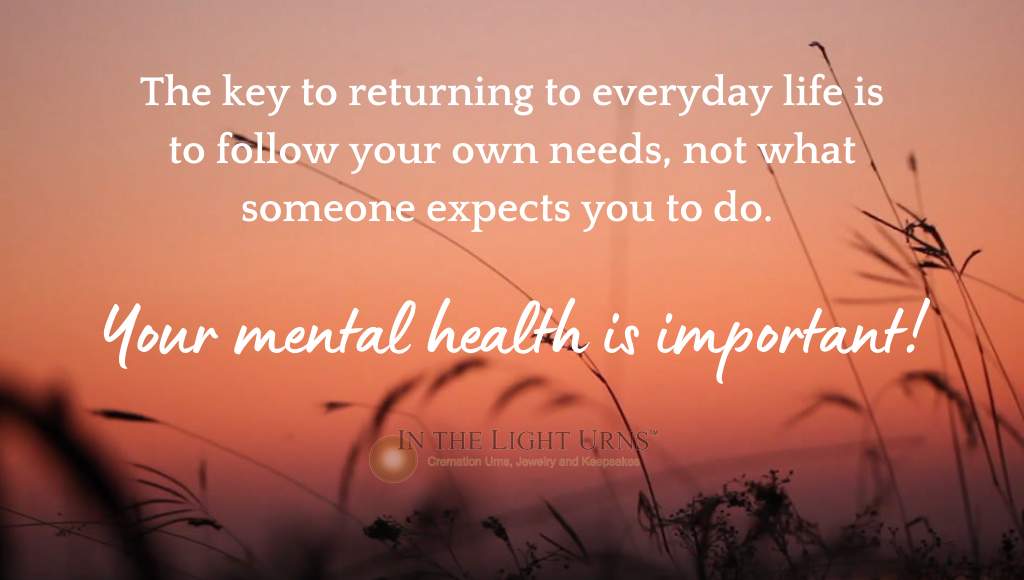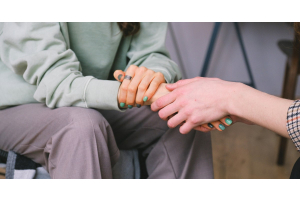
Losing a loved one is not easy. It can leave you feeling like you are missing a part of yourself like there is a gaping hole in the center of your being. It may seem like you will never feel normal again, that life will never feel the same. You might feel like you can never return to your everyday life, but the truth is, you can.
It may not be tomorrow, next week, or next year, but it will happen. It takes some work and a lot of patience, but it will happen.
Grief is natural. It is normal. But no one is intended to stay there.
Grief is a part of life. Unfortunately, we will all lose someone we love at some point in our lives. And grief is a vital part of healing. It is personal – no two people experience it in exactly the same way.
Whether it’s going back to school, work, or picking up where you last left off, returning to the roles and routines of everyday life, can be challenging. And the truth is, it won’t be the same. But you can find a new normal.
And you can thrive in it.
This article will help you navigate the complex journey that is grief and move forward through this everyday process in the aftermath of losing a loved one.
The Truth About Grief
Grief is a natural response to loss. When you lose someone you love, you grieve for them. It is a normal part of life and is part of the healing process. In order to heal, grief must come first.


No two people grieve in the same way. One person may feel sad and depressed, while someone else may act in an opposite way, partying and filling that empty space with other people and activities.
Grief can bring a variety of emotions such as loneliness, sadness, or a feeling of being lost. It can cause moodiness where you are up one moment and down the next. You might feel tired or have an abundance of nervous energy.
Whatever it brings, it can begin the process of healing.
You’ve probably heard that grief comes in stages. This is true, but what many don’t say is that those stages don’t come in a specific order and there is no set time frame for experiencing each stage. Still, they are important.
These stages are not considered to be the perfect way to consider grief but they can help you understand what you are going through and heal by dealing with the various levels of loss:
- Denial – This is typically the knee-jerk response to loss. The first thing that comes to mind is often “This isn’t happening to me.” It can come from a place of shock, you might feel numb, but the truth is, it’s your brain’s way of dealing with the overwhelming emotions that come with loss. It is a defense mechanism that is designed to help you transition to a state of loss.
- Anger – Once the initial shock wears off and you come face to face with the pain of your loss, you may experience feelings of anger or feelings of frustration, helplessness, and overwhelming feelings of loss. This can cause you to strike out at others, at life, at yourself, at the person who died and left you behind, or at a higher power. Sometimes you are angry at all of them at once.
- Bargaining – At this point, you begin ruminating on things you could have done or think you should have done. Maybe they are things you think may have prevented the loss or maybe they are things you wish you had done. Regret is common. You may try to make a deal with fate or with a higher power.
- Depression – Sadness has probably been a component of your grief experience from the beginning, but now it sets in as you start to comprehend the loss. You begin to realize the full impact of the loss and it can take you down a dark road. Symptoms of depression include crying, unable to enjoy things you once liked, irritability, problems with sleep, brain fog, and decreased appetite. You may experience feelings of loneliness, regret, and extreme sadness like you can’t go on. These feelings can be overwhelming.
- Acceptance – At this stage, you accept the reality of your loss. You understand that it is what it is. You can’t change it. You can’t go back. While you may still be sad, you try to begin the journey of returning to your everyday life.
Grief is very personal. You may move through the stages, only to return and go through them again. They may be n a different order or you may skip some. You may experience them individually or several at once.
The point is, you can’t put grief in a box because it looks different to every person who experiences it.
First Steps into Your New Normal
The person you loved, who was a part of your life, is gone. Your life can never go back to what it was before because they are not in it.
You have to find a new normal.
This new normal includes the memories of the person you lost instead of having them there with you. And memories can be such a beautiful, therapeutic thing!


Write down stories
Write down stories that you share with them, things you did together, or things they did – happy things, joyful things. Keep them close so that when you start to feel sad you can remember the good times, the good things. As you heal, these things will help soothe the hurt.
But one thing to remember, grief does not have a clock. You grieve as long as you grieve. At some point, you will move on, but it doesn’t have to be today.
Unfortunately, work and school are two areas that do have time limits and you may have to return before you feel you are ready. This can be stressful, but there are some things you can do to ease the transition.
Returning to work after losing a loved one
Returning to work can be helpful. The routine and busyness of it may help to occupy your mind and it can be a source of stability. But it can also be tough to focus and be very overwhelming. These tips may help:
- Ease back into work if you can. If possible, do half days to make it more manageable.
- Make sure that your coworkers know about your loss before you return. This will help you avoid the questions and having to tell people over and over.
- Set boundaries. If you don’t want to talk about it, that’s OK. Don’t talk about it.
- You may want to talk to HR or your manager to help you set boundaries and inform coworkers. You might also ask that they share information with your coworkers about grief so they can be a little more sensitive to what you are going through.
- Because it can be very difficult to focus during this time, you may want to have someone look over your work. Ask someone you trust to be your second set of eyes.
- Be a list maker. Grief brain fog is real so don’t rely on your memory. Write it down.
- Take breaks. Taking short breaks during the day can help you cope better. If possible, get up and walk, even if you climb a flight of stairs. Taking a break and getting your body moving can be very helpful for fighting depression.
- Keep good lines of communication between yourself and your leadership. If you are struggling, they need to know.
- Be kind to yourself. Don’t push too hard, take breaks, and don’t forget to eat.
Returning to school after losing a loved one
Often, you can get a few days off after you lose someone, then you have to return to class. And you might feel like you are not ready. Going back to school after a loss can be very hard. You might be working through the grief-induced brain fog and you just might not feel like doing anything at all, especially going to school. These tips can help you gently move back into your school routine. If you have a child who is returning to school, you will probably have to do some of these for them or help them.
- If you are really struggling, take a semester off if possible. It is better to take a semester off than to try to force yourself to do well in school.
- Talk to your professors or teachers and your school administrators. In college, you might talk to the dean of students. Explain what has happened and that you are struggling. They may have resources to help you, but at the very least they can help you transition back to the classroom.
- Talk to the guidance counselor. They are there to help students be successful in their academics, but they also understand grief and are trained to help students who struggle with challenges and emotional difficulties.
- Communicate with your teachers or professors. If you are struggling, they need to know. Don’t wait until you feel buried in work, talk as soon as you start to feel the pressure.
- Enlist the help of a friend, teacher, or administrator to help you field questions from other students. Having friends who will act as a buffer for you is invaluable. They can help keep you from telling your story over and over.
- Think about things you can do to decompress or cope while at school. Being able to take a break and go somewhere quiet or have someone you can talk to.
- Give yourself permission to enjoy going back to school. It’s OK to feel energized when you work on a project or laugh with friends. Give yourself a break.
There’s a lot to navigate when you are returning to everyday life after a loss. They can all be handled in a similar fashion whether you are returning to your friends, church, social media, social events, clubs, groups, or anything that involves people.
Set boundaries. You don’t have to talk about it if you don’t want to.
Enlist a friend to go before you. They can tell people, explain your boundaries, and help you manage those first ventures into your regular life.
Don’t jump in all at once. Choose one or two activities every week or two, at least at first. You can build on that more later, but overdoing it will just exhaust and overwhelm you.
You can post an announcement on social media, or you can have a friend do it and field the responses.


When the House Just Seems Too Empty After Losing a Loved One
When the person you lived with passes away, the house can suddenly feel way too empty. Even if others live in the house with you, the dynamic will be different. You will feel that loss because it colors everything – routines, entertainment, hobbies, and traditions.
The thing is, you can’t escape the feeling of sadness that comes with grief. You can’t escape the feeling of loss. You can’t escape the empty feeling because that person is no longer there.
It is hard to face those feelings, but it is an important part of the healing process.
Getting through those days where everything you look at is a reminder of that person can feel so hard, but you can do it. These tips can help:
- At some point, you will put away the person’s things, but it doesn’t have to be today. You can do it a little at a time, or all at once, whatever makes you comfortable. However, getting rid of their belongings while your emotions are still raw can cause you to make rash decisions that you will regret later. If it hurts too much to look at the person’s things in your home, pack them in a box and revisit it later when you have healed some and aren’t so emotional. Otherwise, you could get rid of things that you later regret.
- Let friends and family sit with you. Sometimes it just helps to have another body there. If you don’t want to talk, let them know. But do try to interact with them some because you need that human contact.
- Take time to exercise and get your body moving. Exercise is great for helping with depression.
- Get into a routine. Set alarms if you have to and create a schedule for getting up, showering, exercising, eating, and anything else that you do.
- Keep a favorite item of the person’s if it brings you comfort.
- Avoid sitting in an empty, dark, quiet house, ruminating on your loss. This will only drive you deeper into depression. Do things to bring light and life to your space. Get a plant. Get a pet, open a window, turn on some music, anything to elevate the mood.
The key to it all, to getting back into your everyday life, is to avoid stagnating or ruminating on your loss. It is OK to feel sad, OK to grieve. It is not OK to let your life end when theirs did.
There’s No Right Way to Grieve – Your way is the Right Way!
The thing about grief is that it is personal. Everyone does it differently.
Cremation Memorials and Healing
One thing that we have found in our line of work is that some people after their loved one is cremated will keep the cremation ashes stored in the original cardboard container the crematorium provides. Often they will keep those stored ashes out of sight for over a year before deciding what to do with them.
And that’s OK.
There are some people who don’t want to have a cremation urn displayed in their home because it serves as a painful reminder of their loss.
That’s OK too.
When the time comes to consider what to do with the cremation ashes, don’t feel pressured to go the traditional route of purchasing an urn and having to display it somewhere in your home, especially if you feel that would work against your healing progress rather than help you move forward.
Instead, one way to go about it is if you memorialize your loved one at this moment by whichever method you feel is most fitting and appropriate. Memorializing them can become the most effective way to reach some type of closure for yourself, a moment where you can truly feel like you’re finally letting go of the pain and hurt. Memorializing your loved one for this purpose can can be done in many different ways, here are some suggrestions:
- Spread the ashes in nature. They can spread the ashes in the ocean, mountains, forest, or other areas. Check the laws of the area before doing it though because in some places it is illegal. You can get more details here.
Bury the ashes. Many cemeteries will allow people to bury the ashes of their loved one in a plot. Often there is a fee. You may also be able to bury the ashes in other areas, just make sure there is no law against it. - Plant a tree. Some people will bury the ashes and plant a tree on top of them. This gives them a lasting reminder of their loved one.
- Create jewelry from the ashes or put a small amount of the ashes in beautiful cremation jewelry. There are so many ways to incorporate a loved one’s ashes into special items you can take with you, we ourselves have a selection of Cremation Jewelry, specially designed for this purpose.
- Have a memorial service. Having a memorial service for friends and family to gather and remember your loved one is a great way to get closure.
Remember, healing is a process – and a journey.
Go Easy on Yourself – Tips for Adjusting
Adjusting to living a life where a certain person is no longer in it is difficult. You can feel lost and sad and it can be hard to figure out what to do first. You might feel like everything is coming at you at once, almost a feeling of freefalling.
That is normal.
The best advice we can offer is to go easy on yourself. Don’t push too hard too soon. Give yourself time to process the loss, grieve, and start healing. If it takes longer than you think it should, so be it.
The important thing is to experience the grief because then you can start healing.
Try these things when you are trying to adjust to the loss:
- Be patient with yourself. You won’t heal in a day or even a week. It takes time so give yourself a break and be patient.
- Be kind to yourself/ Don’t neglect your daily routines like taking care of yourself, eating, hygiene, and other daily things you do.
- Accept a little loneliness. Loneliness is normal after a loss but don’t let yourself get too isolated.
- Let friends help you. You may feel like pushing everyone away. Don’t. Let friends come help you, whether they are cleaning, cooking a meal, or just giving you a little company. It’s good for you.
- Create a schedule. Schedules are important. Set a time for going to bed, getting up, exercising, eating, everything. It will make a world of difference.
- Understand that healing takes time. You won't wake one morning and be completely healed, but one day you will feel better – and you’ll feel better and better after that.
- Don’t be afraid to ask for help. If you need help, ask for it. No matter how small it seems. Ask.
- Get some rest. Rest is an important part of the healing process. Get rest when you can but avoid staying in bed all day. Get up and move a little. Go for a walk, ride a bike, do something that gets you moving and your heart rate up.
- Arrange your environment or surrounding to work in your favor. Set up your home to work for you. Do things that make you feel comfortable and relaxed.
- Acknowledge the hurt and allow yourself to feel it. Allowing yourself to feel the pain and loss will help you move forward and heal.
- Set goals. Start with small, short-term goals that you can achieve fairly easily.
- Try journaling. For many people, writing down their feelings is very cathartic. It can help them work out issues and work through grief. You can either keep a file on your computer or go old school and use a physical journal, setting pen to paper. There are also some apps available that will guide you through journaling. This may be helpful if you aren’t used to doing it.
- Find a hobby. Find something you enjoy and so it. Try your hand at painting, paper crafts, beading, knitting, writing, needlepoint, latch hook, or any other hobby that will occupy your hands and mind.
- Talk to your doctor. If you feel that your grief is keeping you down or has turned into major depression, talk to your doctor so that you can get help and get healthy.
Action is your best way to start working toward healing. Do things with purpose. Don’t just let things happen around you. Create structure and stick to a schedule.
If you feel you need some help processing your loss, there are resources available:
- U.S. Suicide Hotline: 1-800-273-8255.
- Mental Health Helplines
- American Counseling Association Grief and Loss Resources
- AARP – Grief and Loss
- Hope for Bereaved, Inc.
- Option B
- Concerns of Police Survivors (C.O.P.S.)
- Tragedy Assistance Program for Survivors, Inc. (T.A.P.S.)
- The Compassionate Friends – Supporting Family After a Child Dies
- Parents of Murdered Children (P.O.M.C.)
- Mental Health America – Bereavement and Grief
- Hospice & Community Care – Grief Resources
- Better Help Online Counseling
- National Alliance for Children’s Grief (N.A.C.G.)
- SAMHSA National Helpline – 1-800-662-HELP (4357)
- Find a GriefShare Group
- Billy Graham Ministries – Courage in Grief
You can also look for resources in your area by doing an internet search or asking your doctor. If you are in school or have kids in school, the guidance counselor may also be able to guide you to some more resources to help you and your family in the grief process.
Healing isn’t Perfect, There’s Usually Scars – But You’re Going to be OK


Healing from loss is not a perfect process. When you lose someone it can leave you feeling like you have a gaping hole in your being. But just like a wound on your body, the wound on your heart will heal. It usually leaves a little scar, but healing does take place.
That scar will be the memories that rise up when you hear a certain song or smell a certain smell, when you walk into a certain restaurant or when you pick up the phone to call the person only to remember that they are gone.
But the scar doesn’t have to be a bad thing or a hurtful reminder of loss. Instead, you can turn it into a celebration of life.
When those reminders come up when that scar is rubbed, train your brain to recall the good times, the happy memories of the person you lost.
Let them be a celebration of a life that touched yours in ways that were deep and meaningful and will stay with you for the rest of your life.
Grief is hard. Healing is harder. But you will get to a place where you can smile, where you can enjoy the things you love, where you can laugh, and where you can find pure joy.
Life keeps going on, even though we feel like stopping sometimes. We have to keep moving forward for us, for our families, and for the loved ones we’ve lost.
They wouldn’t want you to curl up and withdraw from the world.
They would want you to LIVE. What can you do to start living today?






